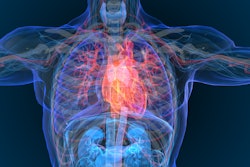CHICAGO – Siemens Healthineers has introduced a new dual-source scanner and a single-source system at RSNA 2024 as part of its new Naeotom Alpha class of photon-counting (PCCT) offerings.
Naeotom Alpha.Pro is a dual-source scanner, while Alpha.Prime will be the vendor’s first single-source PCCT system. Meanwhile, the company’s flagship Naeotom Alpha scanner has been refreshed with new hardware and software and has been renamed as Alpha.Peak. All three Alpha scanners feature the company’s spectral imaging capabilities and AI and automation features. They also all utilize Siemens’ Quantum HD technology, which can display anatomical details in high-resolution at a slice thickness of 0.2 mm, according to the vendor.
The dual-source Alpha.Pro, which can deliver scan times as fast as 491 mm/sec, is particularly suitable for pulmonology, cardiology, and pediatrics, according to Siemens. It can also serve as a high-performance scanner for complex cases as the core of a hub-and-spoke network, with other scanners handling routine exams, the firm said.
 Naeotom Alpha.Pro dual-source CT scanner. Image courtesy of Siemens Healthineers.
Naeotom Alpha.Pro dual-source CT scanner. Image courtesy of Siemens Healthineers.
“The Pro should really move us from the academic centers that we have catered mostly to with the Alpha (now the Alpha.Peak) into the high-volume, tertiary care levels,” said Dr. Philipp Fischer, head of CT at Siemens. “There are no limitations to that system and that should really become our main line, dual-source system for all of the non-academic, but high-end tertiary care settings.”
Also making its RSNA debut is Alpha.Prime, a single-source PCCT scanner targeted at in-patient, ambulatory, and emergency room exams at standalone institutions and large integrated delivery networks (IDNs). Alpha.Prime can also serve as an entry point for a periphery scanner in a hub-and-spoke network. Siemens has migrated its AI-based myExam Companion software, which guides users through system and patient preparation, image acquisition and reconstruction, evaluation, and postprocessing.
 Naeotom Alpha.Prime single-source scanner. Image courtesy of Siemens Healthineers.
Naeotom Alpha.Prime single-source scanner. Image courtesy of Siemens Healthineers.
“The Alpha.Prime is for those that look for entry into the photon-counting Alpha class and want to find the best price point into it,” Fischer told AuntMinnieEurope.com. “But it’s also for those centers that don’t really need this high-speed temporal resolution. So we see it mostly then applicable for neuro and musculoskeletal [applications], but we’ve seen also moving photon-counting to outpatient centers. This is going to be the system to cater to that demand.”
At the top of the Alpha class is Alpha.Peak, which offers a scan time of 737 mm/sec and represents the fourth cycle of hardware and software enhancements for Naeotom Alpha since its introduction in 2021.
 Naeotom Alpha.Peak high-end dual-source CT scanner. Image courtesy of Siemens Healthineers.
Naeotom Alpha.Peak high-end dual-source CT scanner. Image courtesy of Siemens Healthineers.
“We’re going to move our installed base [of Naeotom Alpha scanners] into that performance level of the Peak,” Fischer said.
The introductions also mark the firm’s decision to focus exclusively on photon-counting CT technology for its high-end systems.
“So the high-end, after RSNA, we are moving out of conventional CT and everything will be photon-counting in this segment,” Fischer said.
The new scanners are currently pending U.S. Food and Drug Administration (FDA) 510(k) clearance and Siemens expects them to be commercially available in the first half of 2025.
For full 2024 RSNA coverage, visit our RADCast.




















